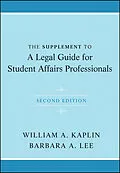Based on A Legal Guide for Student Affairs Professionals, SecondEdition, this indispensable resource offers guidance on recentlegal developments affecting higher education institutions andprograms. The Supplement provides analysis, commentary, andresources especially for student affairs practitioners and graduatestudents in student affairs administration courses. The Supplement covers developments from mid-2008 throughDecember, 2010. It includes discussions of court opinions,statutes, regulations, and related developments, as well asbibliography entries and text citations to selected law journalarticles, books, web sites, and other new resources. Topics coveredinclude: the Higher Education Opportunity Act; litigation involvingonline courses and programs; the U.S. Supreme Court's decision inthe Christian Legal Society case on student organizations'membership policies; new cases involving students withdisabilities; new federal rules on federal student loan programs;student academic dismissals and codes of professional ethics; newdevelopments in student discipline; institutional liability forstudent suicide; guidelines for searching residence hall rooms; andcampus security issues.
Autorentext
WILLIAM A. KAPLIN is professor of law emeritus at The Catholic University of America, Washington, DC, where he also served as special counsel to the Office of General Counsel. He is now senior fellow at the Center for Excellence in Higher Education Law and Policy, Stetson University College of Law.
BARBARA A. LEE is professor of human resource management at Rutgers University's School of Management and Labor Relations and of counsel to the law firm of Edwards Wildman Palmer. An attorney, she teaches employment law and higher education law.
Together they are the authors of The Law of Higher Education, now in its fifth edition.
Klappentext
Based on A Legal Guide for Student Affairs Professionals, Second Edition, this indispensable resource offers guidance on recent legal developments affecting higher education institutions and programs. The Supplement provides analysis, commentary, and resources especially for student affairs practitioners and graduate students in student affairs administration courses.
The Supplement covers developments from mid-2008 through December, 2010. It includes discussions of court opinions, statutes, regulations, and related developments, as well as bibliography entries and text citations to selected law journal articles, books, web sites, and other new resources. Topics covered include: the Higher Education Opportunity Act; litigation involving online courses and programs; the U.S. Supreme Court's decision in the Christian Legal Society case on student organizations' membership policies; new cases involving students with disabilities; new federal rules on federal student loan programs; student academic dismissals and codes of professional ethics; new developments in student discipline; institutional liability for student suicide; guidelines for searching residence hall rooms; and campus security issues.
Inhalt
Notice of Web Site and Periodic Supplements v
Preface xiii
Acknowledgments xv
About the Authors xvii
PART ONE PERSPECTIVES AND FOUNDATIONS.
1. Overview of Higher Education Law 1
1.3 The Governance of Higher Education 1
1.3.1 Basic concepts and distinctions 1
1.3.3 External governance 1
1.4 Sources of Higher Education Law 2
1.4.2 External sources of law 2
1.5 The Public-Private Dichotomy 2
1.5.2 The state action doctrine 2
1.6 Religion and the Public-Private Dichotomy 3
1.6.3 Governmental support for religious institutions 3
1.6.4 Religious autonomy rights of individuals in public postsecondary institutions 7
Selected Annotated Bibliography 9
2. Legal Planning and Dispute Resolution 10
2.2 Litigation in the Courts 10
2.2.3 Judicial (academic) deference 10
2.4 Institutional Management of Liability Risk 10
2.4.1 Overview and suggestions 10
Selected Annotated Bibliography 11
PART TWO THE COLLEGE, ITS GOVERNING BOARD, AND ITS EMPLOYEES.
3. The College and Its Trustees 12
3.1 The Question of Authority 12
3.1.1 Overview 12
3.1.2 Trustee authority 12
3.2 Institutional Tort Liability 13
3.2.1 Overview 13
3.2.2 Negligence 13
3.2.2.4 Liability for cocurricular and social activities 14
3.2.2.5 Student suicide 14
3.2.3 Educational malpractice 16
3.4 Institutional Liability for Violating Federal Constitutional Rights (Section 1983 Liability) 16
Selected Annotated Bibliography 16
4. The College and Its Employees 18
4.2 Employment Contracts 18
4.2.3 Coaches' contracts (new section) 18
4.3 Collective Bargaining 19
4.3.3 Collective bargaining and antidiscrimination laws 19
4.4 Personal Liability of Employees 20
4.4.2 Tort liability 20
4.4.4 Constitutional liability (personal liability under Section 1983) 21
4.4.4.1 Qualifi ed immunity 21
4.4.4.2 Issues on the merits: State-created dangers 21
4.5 Employment Discrimination 21
4.5.2 Sources of law 21
4.5.2.1 Title VII 21
4.5.2.2 Equal Pay Act 24
4.5.2.5 Americans with Disabilities Act and Rehabilitation Act of 1973 25
4.5.2.6 Age Discrimination in Employment Act 26
4.5.2.7 Genetic Information Nondiscrimination Act (new subsection) 28
4.5.2.8 Constitutional prohibitions against employment discrimination 28
4.5.2.11 Transgender (new subsection) 29
4.7 Application of Nondiscrimination Laws to Religious Institutions 29
4.8 Faculty Academic Freedom and Freedom of Expression 30
4.8.1 General concepts and principles 30
4.8.1.1 Faculty freedom of expression in general 30
4.8.1.6 Institutional academic freedom 31
4.8.2 Academic freedom in teaching 33
4.8.2.1 In general 33
4.8.2.2 The classroom 34
Selected Annotated Bibliography 35
PART THREE THE COLLEGE AND ITS STUDENTS.
5. The Legal Status of Students 37
5.2 The Contractual Rights of Students 37
5.3 Student Academic Freedom 40
5.4 Students' Legal Relationships with Other Students 41
5.5 Student Files and Records 42
5.5.1 Family Educational Rights and Privacy Act (FERPA) 42
5.5.2 State law 43
Selected Annotated Bibliography 44
6. Admissions and Financial Aid 45
6.1 Admissions 45
6.1.1 Basic legal requirements 45
6.1.4 The principle of nondiscrimination 46
6.1.4.1 Race 46
6.1.4.2 Sex 46
6.1.4.3 Disability 47
6.1.4.4 Immigration status 47
6.1.5 Affi rmative action programs 47
6.2 Financial Aid 48
6.2.1 General principles 48
6.2.2 Federal programs 48
6.2.4 Affi rmative action in fi nancial aid programs 51
6.2.5 Discrimination against nonresidents 51
6.2.6 Discrimination against aliens 52
6.2.6.2 Undocumented aliens 52
Selected Annotated Bibliography 53
7. The Campus Community 55
7.1 Student Housing 55
7.1.1 Housing regulations 55
7.1.2 Searches and seizures 57
7.2 Campus Computer Networks 58
7.2.1 Freedom of Speech 58
7.2.2 Liability issues 58
7.3 Campus Security 61
7.3.1 Security offi cers 61
7.3.2 Protecting students against violent crime 62
7.3.3 Federal statutes and campus security 63
7.4 Other Support Services 63
7.4.2 Health services 63
Selected Annotated Bibliography 63
8. Academic Policies and Concern…
